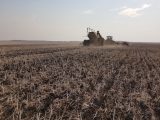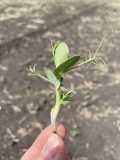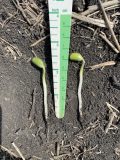 May 26, 2021
May 26, 2021
- Crop Update
- Weather Update
- Dry Bean Seeding Recommendations
- Pre- and Post-Emergent Dry Bean Herbicide Options
- Pre- and Post-Emergent Soybean Herbicide Options
- Soybean Seed Depth Assessment
- On-Farm Network Update
- Scouting Sessions: Scouting and Trapping for the Pea Leaf Weevil
- Resources to Stay Connected
- New Fact Sheet! Guide to Conducting On-Farm Trials
- Quick Links to Production Resources
Listen to The Bean Report:
Crop Update
- Soybean seeding really took off for most farms over the last two weeks, with most acres seeded ahead of the May long weekend (70-95% complete across the province). The seeding window is still open for the remaining soybean acres and maximum yield potential can be achieved by planting before the end of May. Soybeans that were planted during the first half of May have emerged and are currently at the VE (emergence) to early VC (unifoliate) stages. Soybean seed depth is variable in many fields. Most seed was driven deep to access soil moisture. In some cases, soil moisture dropped even lower without timely rains following seeding, leaving partially germinated seeds to desiccate.
- Dry bean seeding ramped up last week (55-65% complete) and is continuing into this week. Seeding is on pause in some fields due to wet soil conditions following the long weekend rain. Seeds have germinated and plants will soon emerge. With this week’s frost risk, it is good news that most bean seedlings are still safely underground.
- Field pea seeding is complete in the province, with crops ranging from V1 (1st true node) to V4 (4th true node) in western Manitoba and V2 to V6 in central and eastern Manitoba. Keep an eye on true node stages of pea crops as you apply post-emergent herbicides. The cut-off for most products is V6 and plants with short stature may be surprisingly advanced due to dry conditions during early development.
- Faba bean crops have been slow to emerge with the lack of moisture. Emerged crops are currently at the V1 (first leaf) stage.
Seeding Progress of All Crops in Manitoba
Weather Update
Frost in the Forecast
Frost is in the forecast tonight, with expected lows of -1°C to -5°C around the province. Peas and faba beans have good frost tolerance, as their growing points are located below ground. If damaged, pea and faba bean plants can regrow from the seed below ground, or from the scale nodes if the main stem has been damaged. For crops with more advanced development, this can negatively influence crop uniformity.
On the other hand, soybeans and dry beans are susceptible to frost damage because their growing points are located above ground. At this time, most dry bean crops have not emerged yet and are safe from frost, but emerged soybean seedlings are at risk of damage. The level of damage incurred will depend on the severity and duration of freezing temperatures. Temperatures lower than -2°C are considered to be a hard or killing frost, and there is a risk of severe damage if these temperatures persist for more than 2 hours.
Scout your soybean fields 3-5 days after the frost event to assess the growing points and plant stand. Count the number of healthy plants and those that have green tissue and show signs of regrowth. If plant populations are very low (<80,000 plants/ac), re-seeding options should be considered.
Factors that influence frost severity:
- Duration of cool temperatures – longer duration of freezing temperatures can cause more damage.
- Soil moisture – moisture in the soil will retain heat.
- Wind speed – stronger wind can reduce the severity of frost.
- Cloud cover – more nighttime cloud cover can reduce plant damage.
Precipitation
Most areas of Manitoba finally received rainfall amounts worth calling home about (20-30+ mm) over the May long weekend. Areas along the western edge and in the central and eastern regions of the province received the most rain (>40 mm). However, there were pockets that received less than 20 mm along the U.S. border in the western and central areas of the province and northern areas located to the west and east of Lake Manitoba.
Find more detailed weather stats, including rainfall amounts from the past 8 days and rainfall since May 1 in the Manitoba Agriculture and Resource Development Crop Weather Report.
Dry Bean Seeding Recommendations
- Plant dry beans from late May to early June, once soils have warmed to 15°C. MASC seeding deadlines are June 10 for risk area 1 and June 6 for risk areas 2, 3 and the insurance test area.
- Plant at a depth of 0.75 – 1.5”, placing seeds into moisture.
- Dry bean inoculants and nitrogen fertility recommendations are currently being researched at the University of Manitoba (U of M). So far, the inoculants available to farmers had little success, so nitrogen fertilization to an average rate of 70 lbs of N per acre continues to be standard practice. This means 70 lbs as a combination of residual soil N and applied N.

- Research on row widths and plant populations for pinto and navy beans has recently wrapped up at the U of M. Dry beans can successfully be planted in narrow (<15”) or wide rows (>15”), with black, navy and pinto bean types typically being better suited to narrow-row production. Research has indicated a yield advantage (90% yield increase) to planting these bean types in narrow rows (7.5”), targeting plant stands of 80-120,000 plants/ac.
- Target plant populations vary with market class, seed size and, in some cases, row width (see table below). Dry bean seed is susceptible to damage from handling, whether you’re cleaning seed, treating seed, or running it through equipment. Soak tests reveal if seed coats have been cracked or damaged and are a useful tool to help you adjust your seeding rates before planting.
- Rolling in dry bean fields is more common if you’re planning for direct harvest. When rolling post-emergence, target the V1 to V2 stages and roll during the afternoon of a warm (25°C+) day. Check for breakage as you go.
Pre- and Post-Emergent Dry Bean Herbicide Options
Pre- and Post-Emergent Soybean Herbicide Options
Soybean Seed Depth Assessment
The optimum seed depth for soybeans in Manitoba is 0.75 to 1.75 inches. Ensuring seed depth is within the optimum range will strongly influence soybean yield.
- Dig for seed carefully using a good digging tool (one that is small, sturdy and has a ruler). Scrape away soil within the furrow to uncover seed or underground seedlings. Measure the distance from the seed to the top of the true soil surface. This does not always equate to the top of the furrow. Check different furrows along the seeder, noting whether you are in a wheel track or not.
- Post-emergent seed depth assessment can be done by measuring the length of white space along the hypocotyl from the root hairs to the green tissue.
- Does your equipment influence seed depth? If your seeder has openers that dig a deep furrow and create bigger hills, and/or if you have wide packing wheels that push more soil over the furrow, your seed may end up deeper than intended. Rolling afterward may add even more soil to the furrow. Try to anticipate how much additional soil will be pushed onto the furrow after rolling. Check seed depth after rolling to accurately estimate this and achieve the seed depth you want in future years.
- Symptoms of deep seeding may include a swollen hypocotyl, elongated hypocotyl arch, yellow cotyledons above or below ground and/or loss of cotyledons. Deep seeding is considered to be >1.75 inches, according to the most recent research from the Soybean and Pulse Agronomy Lab in Manitoba.
- Symptoms of shallow seeding include seed stranding, where seeds did not make it into the furrow, desiccated seeds within the furrow that partially germinated then ran out of moisture or reduced plant stand after emergence.
Update from the On-Farm Network
Most of the On-Farm Network trials are in the ground, with just a few more soybean and dry bean trials to plant. We have quite a diverse program lined up this season, with more trial types in peas and dry beans than ever before. Whether you have questions about soybean row spacing, dry bean fertility, pea seeding rates, faba bean fungicide or lots of things in between, the 2021 OFN program has something for you! Stay tuned to The Bean Report, OFN in the Field and follow along on Twitter (@OFNagronomist) to keep up with the OFN team this season!
Scouting Sessions: Scouting and Trapping for the Pea Leaf Weevil
Resources to Stay Connected
 While we operate in a virtual space again in 2021, there are several resources available to stay connected and learn from experts in the industry. This year, the agronomy team at MPSG is bringing you Scouting Sessions – a series of short videos on timely and interesting pulse and soybean topics. These videos will be available on our social media, website and in The Bean Report throughout the season!
While we operate in a virtual space again in 2021, there are several resources available to stay connected and learn from experts in the industry. This year, the agronomy team at MPSG is bringing you Scouting Sessions – a series of short videos on timely and interesting pulse and soybean topics. These videos will be available on our social media, website and in The Bean Report throughout the season!
Educational resources to sign up for:
- Manitoba Agriculture and Resource Development CropTalk Webinars – CCA credits available!
- Manitoba Crop Report, Crop and Pest Report, Crop Weather Report
- North Dakota State University Crop and Pest Report
- Ag In Motion Digital Pass
- Saskatchewan Pulse Growers Newsletters, Podcasts and Resources
New Fact Sheet! Guide to Conducting On-Farm Trials
Quick Links to Production Resources
Soybeans
- Production Guidelines
- Fertility Factsheet
- Seed Treatment Risk Assessment
- Growth Staging and Maturity Guide
- Plant Development Guide
- Insect and Disease Scouting Calendar and Identification Guide
- Soybean Aphids: Identification, Scouting and Management
Field Peas
- Production Guidelines
- New! Organic Production Guidelines
- Growth Staging and Maturity Guide
- Insect and Disease Scouting Calendar
- Root Rot in Peas and Lentils
- New! Fungicide Decision Worksheet for Mycosphaerella Blight
- New! Desiccation and Harvest Guide
Dry Beans
- Growth Staging and Maturity Guide
- Insect and Disease Scouting Calendar
- Fungicide Decision Worksheet for White Mould
- New! Desiccation and Harvest Guide

































